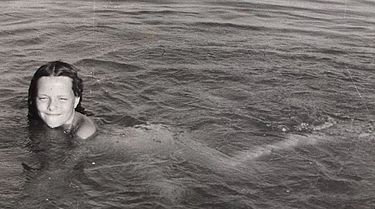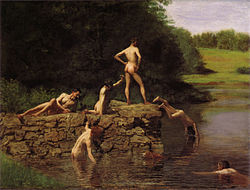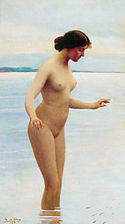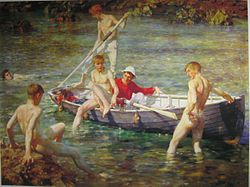- Nude swimming
-
Nude swimming, colloquially called skinny dipping, is a term used to describe swimming naked.
Contents
Etymology
The term skinny dip, first recorded in English in the 1950s, includes the somewhat archaic word skinny, known since 1573, meaning "having to do with skin", as it exposed the naked body.
Definitions
The term is commonly used with a neutral tone to describe swimming in unheated water, but is also used when referring to going naked in hot tubs and hot springs.
It has a more mischievous connotation when describing swimming excursions (often under cover of darkness) in swimming pools or at beaches where one would be expected to wear swimsuits. Some people claim that skinny dipping in mixed company (i.e., both males and females) has an element of sexual rebelliousness to it, though sexual activity does not necessarily take place. However, skinny dipping does not necessarily have any sexual component, it may just be an enjoyable activity between platonic friends.
In the United Kingdom, skinny dipping is sometimes known as "naked swimming". This term can also be applied to swimming in nature.
History
Prior to the mid-19th century, swimming nude was unexceptional. Francis Kilvert, a skinny-dipper (1873), describes men's bathing suits then coming into use as "a pair of very short red and white striped drawers".[1] Period illustrations of women's suits show they were far more cumbersome.
Benjamin Franklin, an avid swimmer, possessed a copy of the Art of Swimming by Melchisédech Thévenot, which featured illustrations of nude swimmers. Among other notable Americans, Presidents John Quincy Adams and Theodore Roosevelt are perhaps the best-known skinny-dippers. Roosevelt describes nude swims in the Potomac with his "tennis cabinet" in his Autobiography: "If we swam the Potomac, we usually took off our clothes."[2] Quotations from the diary of Rev. Francis Kilvert, an English nude swimmer, in Cec Cinder's The Nudist Idea, show the transition in the England of the 1870s from an acceptance of nude bathing to the mandatory use of bathing suits. Kilvert describes "a delicious feeling of freedom in stripping in the open air and running down naked to the sea".[3]
Although modern swimwear is more practical, nude swimming remains a fairly common activity in rural areas, where an unwanted audience of outsiders is rather unlikely; yet it may be forbidden even there by law. Today, many swimmers in the U.S. limit nude swimming to private locations due to concerns about public nudity.
Ernest Thompson Seton describes skinny dipping as one of the first activities of his Woodcraft Indians, a forerunner of the Scout movement, in 1902.[4]
Before the YMCA began to admit females in the early 1960s, swimming trunks were not even allowed in the pools,[5] and high school swimming classes for boys sometimes had similar policies, citing the impracticality of providing and maintaining sanitary swimming gear and clogging swimming pools' filtration systems with lint fibers from the swimsuits. These practices were common because of the perception that there was nothing wrong or sexual about seeing members of the same gender in the nude, especially in these indoor contexts among equals in 'birthday suit uniform'. In some areas, this extended well into the early 1970s.
In some English schools, Manchester Grammar School for example, nude swimming was compulsory until the 1970s.[6] This was also the case for some US high [7]and junior high schools.[8] A 2006 Roper poll showed that 25% of all American adults had been skinny dipping at least once, and that 74% believed nude swimming should be tolerated at accepted locations.[9]
In the United States, various counties and municipalities may enact their own dress codes, and many have. There is no federal law against nudity. Nude beaches, such as Baker Beach in San Francisco, operate within federal park lands in California. However, under a provision called concurrent jurisdiction, federal park rangers may enforce state and local laws, or invite local authorities to do so.
While exceptional in the U.S., some nude or more accurately clothing-optional beach areas have been designated or marked by signs by government entities. Among the most widely used are Gunnison Beach in New Jersey (National Park Service) and Haulover Beach in Florida (Miami-Dade County).
In popular culture
- Arts
-
Thomas Eakins, The Swimming Hole (1885)
-
Eugene de Blaas, In the Water (1914)
-
Henry Scott Tuke, Ruby, gold and malachite (1902)
- Nude swimming was a common subject of Old Masters and Romantic oil paintings, usually bucolic or in a mythological or historical setting. In later days it became rarer, but more likely to depict straight-forward contemporary scenes.
- Norman Rockwell's painting No Swimming that adorned the cover of the June 4, 1921 edition of the Saturday Evening Post with boys in various states of undress escaping from the local authorities.
- Films
Several films have become notable in whole or in part due to their nude swimming scenes.
- Ecstasy (1933) The film was censored or banned in many places largely because of Hedy Lamarr's nude swimming scene.
- Tarzan and His Mate (1934) featured the female lead (played by a double) swimming nude, however religious groups lobbied to have the scene removed. Three versions of this movie now exist.
- In Age of Consent, a 1969 Australian film by British director Michael Powell, Helen Mirren swims naked in several scenes.
- Jaws (1975), the character Chrissie Watkins, played by Susan Backlinie, goes skinny dipping in the ocean, and then gets eaten by the shark. Susan Backlinie later reprised the scene in a self-parody in the comedy 1941 (1979), where she is snagged up by the periscope of a surfacing Japanese submarine.
- Books
- Recent bestselling books on "wild swimming" by authors such as Kate Rew and Daniel Start have promoted skinnydipping, recommending suitably secluded beaches, rivers and lakes.
See also
References
- Notes
- ^ In Cec Cinder, PhD: The Nudist Idea, Ultraviolet Press, Riverside, California: 1998, p. 333. ISBN 978-0-9652-0850-5.
- ^ Theodore Roosevelt, "An Autobiography", Library of America, New York: 2004, pp. 298–300.
- ^ quoted in Cec Cinder, PhD: The Nudist Idea, Ultraviolet Press, Riverside, California: 1998, pp. 331–33. ISBN 978-0-9652-0850-5
- ^ Seton, Ernest Thompson (1951), Trail of an Artist Naturalist, London: Hodder and Stoughton, p. 297, ISBN 0-4051-0734-X
- ^ Tate, Cassandra (2001-03-14). "Young Men's Christian Association (YMCA) of Greater Seattle". HistoryLink. http://www.historylink.org/essays/output.cfm?file_id=3100. Retrieved 2007-03-25.
- ^ Cohen, Michael (December 2005), "Swimming Naked at MGS" (PDF), The Mancunian (Old Mancunians), http://www.oldmancunians.org/html/news/current/TOM%2021December%202005.pdf, retrieved 2007-11-27. From about 1930 until at least the 1970s (this author left MGS in 1973).
- ^ National Public Radio =, Aug. 1, http://www.npr.org/templates/story/story.php?storyId=5597441, retrieved 2007-11-27. Naked in High School: Bad Dreams Do Come True
- ^ Nude Swimming at Johnston JHS, 1959 to 61, October 15 December, http://www.houstonarchitecture.com/haif/index.php?showtopic=13416, retrieved 2007-11-27. From about 1951 to 1970?
- ^ Roper poll online, Naturist education, 2006, http://www.naturisteducation.org/Projects/NEF-Roper_Poll_2006/nef-roper_poll_2006.html.
External links
- EtymologyOnLine- Skinny
- Guide to Swimming Holes and Hot Springs
- The Naturist Society
- NetNude (International Social Nudist Website)
- South Florida Free Beaches (Haulover Beach Park)
- Naturist Education Foundation
- B.E.A.C.H.E.S. Foundation
Wikimedia Foundation. 2010.





